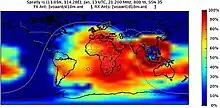VOACAP (Voice of America Coverage Analysis Program)[1] is a radio propagation model that uses empirical data to predict the point-to-point path loss and coverage of a given transceiver if given as inputs: two antennas (configuration and position), solar weather, and time/date. Written in Fortran, it was originally designed for Voice of America.


Some movies on the coverage during daytime can be found here.[2]
Simulating HF propagation conditions
Currently versions based on the original source tree exist for Windows, Linux (voacapl)[3] and OSX.[4] The program core uses text files for I/O and a bunch of wrappers now exist.
Besides commercial visualization tools, there are also Open Source implementations with GUI:
- VOACAP online using ITS' IONCAP model, available at http://www.voacap.com/prediction.html
- the PropagationPython Project.[5] aka "Proppy" which is an evolution and alternate to VOACAP using the new ITURHFProp prediction model (formerly REC533) and always in development by James Watson[6]
For immediate results, VOACAP provides a web interface for both the coverage[7] and the prediction.[8]
See also
References
- ↑ Official Homepage: http://www.voacap.com/
- ↑ Movies of the HF coverage during daytime http://gerolfziegenhain.wordpress.com/2012/07/22/qrp-propagation-simulation-one-day-on-all-ham-bands/
- ↑ Voacap under Linux http://www.qsl.net/hz1jw/voacapl/index.html
- ↑ Installing Voacap under OSX http://gerolfziegenhain.wordpress.com/2012/07/installation-of-voacap-under-osx
- ↑ "Proppy" (PropagationPython) can be download from http://www.qsl.net/hz1jw/pythonprop/
- ↑ Installing "Proppy" under Debian Linux http://gerolfziegenhain.wordpress.com/2012/07/16/installation-of-pythonprop-under-debian/
- ↑ Online Voacap coverage http://www.voacap.com/coverage.html
- ↑ Online Voacap prediction http://www.voacap.com/prediction.html